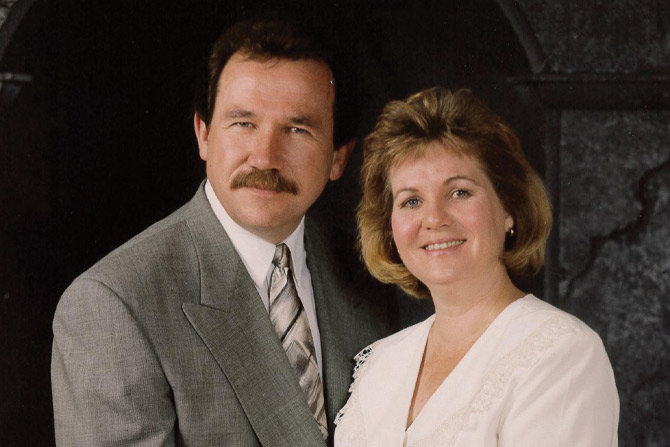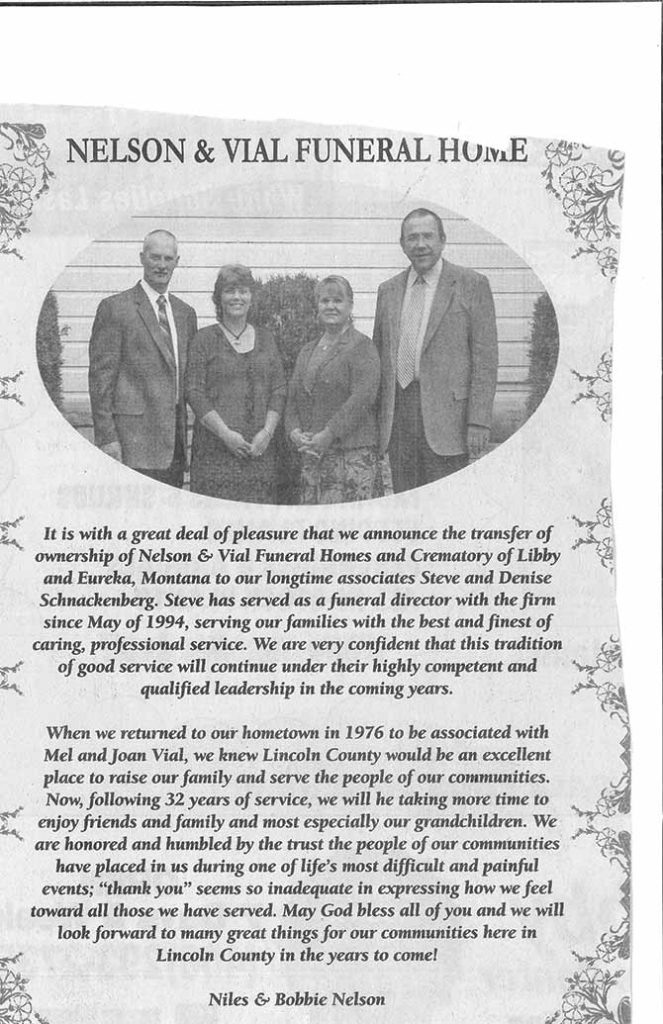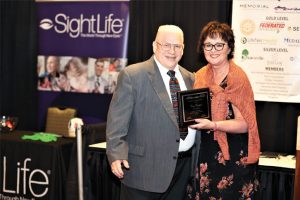MFDA recently honored Niles Nelson for his service and dedication to the Montana Funeral profession. We are honored to have Niles as a member of the association. Below is a brief history of Niles life and career. We hope you enjoy getting know him better.
It has been jokingly said in writers’ circles that two of the most similar written works are a bio and an obit; I’ll attempt to do more of the former at this point, while attempting to avoid the latter despite 46 years of habit as a funeral director.
I was born at the base hospital in Ft. Benning, Georgia, while Dad was serving with the Seventh Cavalry in Korea. Mom assured me, however, that I was indeed made in Montana from genuine Montana parentage, Mom being from Anaconda and Dad from Kalispell. I lived in Polson where Dad had his first job as a band teacher, and then we moved to Libby in 1957 when I was a whole four-and-a-half years old. Dad was the director of music at Libby Public Schools throughout
my entire childhood until my graduation from Libby High School in 1971. While in my junior year, I became hopelessly attracted to a little blond-haired, blue-eyed girl named Bobbie Brown, who was one year my junior. Never pooh-pooh the notion of love at first sight! The knot was tied in 1973 and has remained that way for what will be 49 years later this year.
I moved to Missoula and attended the University of Montana, with a stint in the Army in the middle of the process. I majored in sociology and social work and played with the U of M Jazz Workshop band and the U of M Wind Ensemble to break the monotony. Sociology is about as interesting as watching a lake dry up. In those years, most colleges of mortuary science were private schools and to meet the licensure requirements of two academic college years in addition to one year of mortuary college, this time at U of M was necessary. Most of those private colleges are now gone and have become part of community colleges that offer an AA degree with an “all in one” approach to mortuary science education. This is a much better way, in my opinion.
During that time, my interest in funeral service increased as Bobbie and I lived in the upstairs apartment of Livingston & Malletta Funeral Directors in Missoula. While working previously for the City of Libby during high school, my main job was taking care of the cemetery. During that time, I worked with Mel Vial, the mortician with our local funeral home. I learned much about funeral service from him but based on negative experiences he had in funeral service, he attempted to try and talk me out of it. “What the hell do you want to do this for?!” was his favorite counsel. “It’s a big world out there, and there are lots of other opportunities besides this,” was another. You can see how well I followed his advice.
While living at Livingston & Malletta, John Malletta noticed my extreme interest and desire in funeral service and encouraged me to go to mortuary college as soon as possible. In late December 1974, Bobbie and I headed for southern California, where I enrolled in the California College of Mortuary Science at Los Angeles (now part of Cypress Community College), living upstairs of a small, family-owned mortuary in the downtown district. The semi-retired owner and his son operated the place, and the elder became a wonderful mentor to me in embalming, funeral directing, public relations and funeral service in general, based on his many years of experience. We need more mentors in this profession. I will forever be grateful for the patience, encouragement and teachable moments and more that he so generously gave to me. In December 1975, I graduated with fellow Montanans John Michelotti from Billings and Bill Carter from Plains.
During our absence from Montana, John Malletta acquired Geraghty Funeral Home in Missoula. Upon our return, he placed me at that location, which was managed by Fred Nelson. In retrospect, I feel very blessed to have had more excellent mentorship at that point in my career working under the direct supervision of Fred, a well-experienced funeral
director and embalmer, along with John Malletta and occasionally Tom “Tim” Geraghty, both past presidents of MFDA.
In 1976, we returned to Libby to work for Mel Vial, who had acquired the Gompf Funeral Homes of Libby and Eureka. (I think at that point, he was glad I ignored his advice.) We also started our family: we had two sons and later assisted in raising two nieces and a nephew, all of who were the same age group as our sons, thus becoming our own “Brady Bunch.” It was a very happy memory for us.
Later, I became the manager of the business and then acquired ownership of it in 1992 in partnership with my wife, Bobbie. Ownership comes with long hours but has many rewards as well if you are willing to work for it. During this time, we began to renovate our facility, a ninety-year-old wood frame structure; there were almost no plum walls or square corners, and every wall we opened was like Pandora’s Box. We began to wallpaper our chapel when we discovered two days later we would need it the next day for a service. So we parked the kids in sleeping bags in the lobby and worked all night to get it done, with finish time the next morning at 6:30 a.m. Those times will either bring you closer as a married couple or lead to homicide. We settled, thankfully, for the former. My unending thanks during this process to my associate (and later successor) Steve Schnackenberg, an experienced carpenter, for his assist.
During my tenure as a funeral director and coroner in this territory — stretching from the Canadian border to the Idaho panhandle and from Libby over to the Flathead County line — it is not too much for me to say that this has been the experience of a lifetime. Distances between locations make things hectic, and winter driving can be fraught with difficulties, but when leaving one of our locations for home after a service, there is this incomparable sense of satisfaction knowing that you have done something incredibly meaningful for the living that will stay with them always. It seems more spiritual in recrudescence than just a commodity, skill or job and will remain so until my time for leaving comes too.
In 2008, we sold our business interests to our most valued employee, Steve Schnackenberg and his wife Denise, knowing that the families we serviced would be in good, competent hands. A year later, on a sunny June morning, I had an enjoyable conversation with Dennis Schoepp, a very close friend and colleague in Columbia Falls. A little over
an hour later, his associate called me in a panic, saying Dennis was on his way to the hospital in an ambulance and that it looked very bad. Bobbie and I loaded up the car and headed for Columbia Falls, receiving a call halfway there from his wife saying that they wanted her to “pull the plug” as he was brain dead. For the next thirteen months, we resided in Whitefish as interim managers of the Austin Funeral Home and the Columbia Mortuary in Columbia Falls, which was a very interesting experience that we gladly did in honor of our friend Dennis and his wife, Kenria. Dennis served as President of MFDA on two separate occasions and also served on the NFDA Policy Board; he was a very active member of our association, serving our profession well. During my tenure on the MFDA executive board and later as President, I missed Dennis deeply. Our MFDA scholarship in Dennis’s memory so generously funded by his wife Kenria is a very appropriate tribute and acknowledgment of his service to us all.
In 1997, I was appointed by Governor Marc Racicot to serve on the State Board of Funeral Service and was later re-appointed by Governor Judy Martz for an additional term. During that time, the board re-vamped laws and regulations, both MCA and administrative, almost entirely and added new sections. The last total re-vamp was done in 1962 with many bandaids added on through the years with almost nothing regarding cremation, pre-need and cemeteries, so the task was daunting. I have huge respect for the talent and intelligence of my fellow board members in accomplishing this monumental task, along with the assistance of the adjunct committee of MFDA past presidents Rick Evans and Dean Whitesitt. I was amazed that this massive piece of work made it virtually unscathed across both floors of the legislature; I later found out this was indeed a miracle!
I have come to realize that our ongoing professional development and well-being of funeral service in Montana (or any state) lies, to a large degree, on the relationships we have with one another. I believe this is what our founding MFDA members had in mind over a century ago, and it remains the same.
Part of being a life-long learner is found in relationships. A late colleague and friend, John Austin, founder of Austin Funeral Home, Whitefish, who was a lifelong learner, used to occasionally send along various publications to me dealing with many aspects of funeral service; I always appreciated this. Among the final materials he sent me was a hard-back book on management. He signed off on the inside cover: “Dear Niles, Hope you enjoy this and it contributes to your
learning.” And then he finished cryptically: “It is certain to say that one of us will not be at the other’s funeral. Regards, John.”
I could almost hear him smirking. Point well made.








